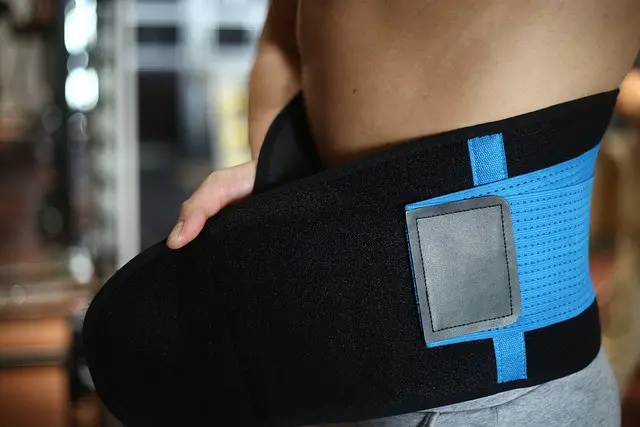As a BetterHelp affiliate, we receive compensation from BetterHelp if you purchase products or services through the links provided
In pursuing an enchanting hourglass figure, many turn to the captivating world of waist training. In this exploration, we delve into the magic of waist training, seeking answers to the intriguing question: Can you sleep with a waist trainer?
The idea of achieving that coveted shape has sparked curiosity and enthusiasm among individuals looking to redefine their silhouettes. Join us on this journey as we uncover the secrets that lie within the realm of waist training.

What is a Waist Trainer?
Waist trainers, often shrouded in mystique, are specialized garments designed to cinch the midsection, offering a transformative shaping effect. Let’s unravel the mysteries surrounding waist trainers to understand their form and function better.
The Design and Material
- Waist trainers come in various designs, but the common thread is their focus on the midsection.
- Typically made from materials like latex or other shaping materials, it provides a snug fit around the waist.
- The tightness of the garment is adjustable, allowing individuals to customize the compression level.
Shaping the Hourglass
- At the core of waist training lies the promise of achieving an hourglass figure.
- Crafted to narrow the waistline, emphasizing the curves of the hips and bust.
- The design aims to create a visually striking silhouette, enhancing natural curves and fostering a sense of confidence.
Different from Corsets
- While waist trainers and corsets share similarities, they are distinct in their purpose and design.
- Waist trainers zero in on the midsection, unlike traditional corsets that focus on shaping the entire torso.
- This targeted approach allows for greater flexibility and comfort, making them suitable for everyday wear.
Beyond Aesthetics: Posture and Core Support
- Waist trainers aren’t merely about aesthetics; they can also impact posture and core muscles.
- By supporting the midsection, these garments encourage an upright posture, potentially reducing strain on the back.
- The compression may engage and strengthen core muscles over time.
In our quest to understand the mysteries of waist trainers, it’s crucial to recognize the marriage of form and function in these garments. They aren’t just fashion accessories; they are tools that individuals use to sculpt their bodies and embrace the allure of the hourglass shape.
Why Waist Train?
Embarking on the journey of waist training involves more than just a desire for a shapely figure; it’s a personal choice rooted in various motivations. Let’s delve into why individuals choose to engage in waist training and its transformative benefits.
Aesthetic Aspirations
- Hourglass Ambitions: The allure of achieving that classic hourglass figure is a driving force for many. Waist training promises to sculpt and accentuate natural curves, fostering a sense of confidence and body positivity.
Confidence Boost
- Enhancing Self-Esteem: Waist training is often embraced to boost self-esteem. As individuals witness the gradual transformation of their silhouette, a newfound confidence emerges, positively impacting various aspects of their lives.
Postpartum Recovery
- Reclaiming Pre-Pregnancy Shape: Postpartum women may turn to waist training to reclaim their pre-pregnancy shape. The compression and support offered by waist trainers can aid in toning abdominal muscles and providing a sense of support.
Support for Weight Loss
- Supplementing Weight Loss Efforts: Some individuals incorporate waist training into their weight loss journey. While not a substitute for a healthy diet and exercise, waist trainers may offer additional support by creating a thermogenic effect, encouraging sweating during workouts.
Back Support and Improved Posture
- Alleviating Back Discomfort: Waist trainers can contribute to better posture by providing support to the midsection. This, in turn, may alleviate discomfort in the lower back, making them appealing to those seeking ergonomic benefits.
Fashion and Style
- Stylish Appeal: Beyond the functional aspects, waist trainers have found a place in fashion. Many individuals use them as stylish accessories, seamlessly integrating them into their wardrobes for casual and formal occasions.
Understanding the motivations behind waist training is essential to appreciate the diverse reasons individuals embrace this practice. Whether driven by aesthetic aspirations, confidence-building goals, or postpartum recovery, each person’s journey into waist training is a unique and personal experience.
Benefits of Waist Training
Waist training goes beyond the physical transformation of the body; it extends into boosting confidence and enhancing overall well-being. Let’s explore how incorporating a waist trainer into your routine can bring these transformative benefits.
Boosting Confidence with an Hourglass Shape
How can a waist trainer enhance your body confidence?
- Visual Transformation: The immediate visual impact of a waist trainer, cinching the midsection, creates a noticeable change in your silhouette.
- Accentuating Curves: Waist trainers are designed to emphasize the natural curves of the hips and bust, fostering a sense of femininity and allure.
- Psychological Empowerment: Witnessing the gradual achievement of the coveted hourglass figure can have a profound psychological impact, instilling a heightened sense of body confidence.
Achieving the coveted hourglass figure with consistent use.
- Consistency is Key: The transformative effects of waist training become more pronounced with consistent use over time.
- Sculpting the Waistline: Through regular wear, the waist trainer contributes to gradually sculpting the waistline, aligning with the desired hourglass shape.
- Confidence Through Progress: Each step towards achieving the hourglass figure becomes a triumph, further enhancing confidence and self-assurance.
Improving Posture and Core Muscles
The impact of waist training on posture.
- Providing Structural Support: Waist trainers, by their design, offer support to the midsection, which translates into improved posture.
- Upright Alignment: The compression applied by the waist trainer encourages an upright alignment of the spine, reducing the likelihood of slouching.
- Reducing Back Strain: Alleviating pressure on the lower back contributes to enhanced comfort and a more graceful posture.
Strengthening core muscles for better overall health.
- Engaging Core Muscles: The constant engagement of abdominal muscles due to compression promotes strength and toning over time.
- Enhanced Core Stability: Improved core strength translates into better overall stability, reducing the risk of injuries and supporting daily activities.
- Comprehensive Health Benefits: Beyond aesthetics, strengthening core muscles positively impacts overall health and well-being.
Incorporating a waist trainer into your lifestyle is not just about physical changes; it’s a journey towards increased confidence and a healthier, more empowered you. The dual benefits of achieving an hourglass shape and enhancing posture and core strength make waist training a holistic approach to personal well-being.
Drawbacks of Waist Training
While waist training offers enticing benefits, exploring potential drawbacks is crucial to making informed decisions about incorporating it into your lifestyle. Let’s delve into the challenges, particularly the night-time dilemma of wearing a waist trainer during sleep.
The Night’s Dilemma: Can You Sleep with a Waist Trainer?
Exploring the possibility of sleeping in a waist trainer.
- Comfort Considerations: The tightness and compression of a waist trainer may pose challenges to comfort during sleep.
- Restricted Movement: Sleeping positions may be limited, impacting your natural sleep habits.
- Breathing Constraints: Depending on the tightness, there could be restrictions on normal breathing patterns.
How it affects your sleep quality and duration.
- Quality vs. Quantity: While wearing a waist trainer may affect sleep quality, it can also influence the duration of your sleep.
- Disrupted Sleep Patterns: Some individuals report disrupted sleep due to discomfort or the need to adjust the waist trainer during the night.
- Individual Variations: Responses to sleeping with a waist trainer can vary; some may find it manageable, while others may experience more significant disturbances.
Health and Safety Concerns
Addressing potential issues with prolonged use.
- Skin Irritation: Prolonged wear may lead to skin irritation or chafing, particularly if the waist trainer is not breathable.
- Organ Compression: Extended midsection compression could affect organ function and circulation.
- Impact on Digestion: Tight waist trainers might contribute to acid reflux or digestive discomfort.
The importance of listening to your body.
- Recognizing Limits: Individual tolerance levels vary, emphasizing the need to listen to your body’s signals.
- Discomfort Signals: Persistent discomfort, numbness, or tingling should not be ignored and may indicate the need to adjust or remove the waist trainer.
- Balancing Act: Achieving the right balance between waist training goals and overall well-being is essential.
Understanding the potential drawbacks of waist training, especially when considering sleep and prolonged use, is vital for making informed choices. As with any lifestyle practice, it’s essential to prioritize your health and listen to your body’s cues, ensuring that the pursuit of an hourglass figure does not compromise overall well-being.
Waist Training Tips
Embarking on a waist training journey requires careful consideration and adherence to best practices. Here are valuable tips to optimize your experience, especially regarding waist training while sleeping.
The Art of Waist Training While Sleeping
Tips for sleeping on your back with a waist trainer.
- Choose the Right Position: Sleeping on your back is recommended for waist training. It allows for even pressure distribution and reduces the risk of discomfort.
- Pillow Support: Place a pillow under your knees to enhance comfort and maintain the natural curve of your spine.
- Adjust Tightness: Before sleep, ensure your waist trainer is snug but not overly tight, allowing for comfortable breathing and movement during the night.
Considering the impact on stomach acid and acid reflux.
- Avoid Tightness Pre-Bed: Tightening the waist trainer too much before bedtime may exacerbate stomach acid issues. Loosen it slightly to reduce potential pressure on the stomach.
- Observe Your Body: If you experience acid reflux or discomfort, consider adjusting your waist trainer or opting for nights without it to prioritize your digestive health.
Recommended Usage Times
Finding the balance: How many hours a day should you wear a waist trainer?
- Start Gradually: Begin with shorter durations, gradually increasing the hours. This allows your body to adjust to the compression and reduces the risk of discomfort.
- Listen to Your Body: Pay attention to any signs of discomfort or fatigue. If you experience adverse effects, decrease the wearing time and consult with a healthcare professional if necessary.
Understanding the American Board of Cosmetic Surgery’s recommendations.
- Professional Guidance: The American Board of Cosmetic Surgery provides valuable recommendations for safe waist training practices.
- Limit Daily Use: While guidelines may vary, it’s generally advised not to exceed a certain number of hours daily to prevent potential health risks.
Incorporating these waist training tips into your routine can contribute to a more comfortable and effective experience. Remember, it’s essential to prioritize your well-being, listen to your body, and seek professional advice if needed.
Choosing the Right Waist Trainer
Selecting the right waist trainer is crucial for a comfortable and effective waist training experience. Here’s a guide on why quality matters and how to find the perfect fit.
Quality Matters: Finding the Perfect Fit
Selecting the right material and design.
- Material Considerations: Opt for high-quality materials like latex or other shaping fabrics. These materials should be breathable, durable, and flexible for daily wear.
- Breathability: Ensure the waist trainer allows proper air circulation to prevent discomfort, especially during extended wear.
- Design Features: Look for a design that complements your lifestyle. Some waist trainers are discreet and suitable for everyday use, while others may be designed for specific occasions or workouts.
Ensuring a snug fit for effective waist training.
- Measure Accurately: Take accurate measurements of your waist before purchasing a waist trainer. Follow the sizing chart provided by the manufacturer to find the right size.
- Snug but Comfortable: A snug fit is essential for practical waist training but should not be overly tight. The trainer should comfortably compress your midsection without causing discomfort or restricting movement.
- Adjustability: Opt for a waist trainer with adjustable closures. This allows you to customize the tightness as your body adjusts and progresses in your waist training journey.
Tips for Trying and Testing
- Comfort Test: Wear the waist trainer for short periods to ensure it doesn’t cause discomfort or irritation.
- Range of Motion: Perform simple movements while wearing the trainer to gauge its impact on your flexibility and ease of movement.
- Gradual Progression: Gradually increase the duration of wear as your body adapts to the compression, ensuring comfort and effectiveness.
Choosing a quality waist trainer with the right fit is foundational in your waist training journey. By prioritizing material, design, and fit, you set the stage for a positive and rewarding experience where comfort and effectiveness are maximized.
The Enigmatic Journey of Waist Training: Sculpting the Silhouette While Dreaming in Comfort
The desire for an hourglass figure has driven many individuals towards waist training. It’s a modern method to achieve a classic silhouette that accentuates natural curves. Amidst the growing popularity of waist training, a pertinent question arises: Can you continue waist training even as you sleep? In this exploration, we delved into the essence of waist training, unraveling its principles and examining its effects on our bodies, particularly during the hours of rest. Through a blend of curiosity and information, we aim to shed light on the practice of waist training, helping you understand its potential benefits and challenges as you consider integrating it into your daily routine.
Here are some key takeaways from our exploration:
- The Aesthetic Appeal:
- Waist training offers a gateway to the coveted hourglass figure, accentuating natural curves and fostering a sense of feminine allure.
- The Functional Side:
- Beyond aesthetics, waist trainers support the midsection, aiding in posture correction and potentially alleviating back discomfort.
- Individual Endeavor:
- The motivations behind waist training are as diverse as those who embrace it, be it for postpartum recovery, self-esteem enhancement, or a stylish accessory.
- The Night-time Narrative:
- Sleeping with a waist trainer is a nuanced dialogue between comfort and goals. The decision to do so should be carefully considered, bearing in mind the potential impact on sleep quality and overall comfort.
- Guided Approach:
- Embracing the practice responsibly by selecting a quality waist trainer, adhering to professional guidelines, and listening to one’s body sets the stage for a positive and rewarding waist training experience.
- Professional Insight:
- Seeking professional guidance and adhering to safe practices as outlined by reputable sources like the American Board of Cosmetic Surgery ensures a balanced and health-conscious approach to waist training.
- Quality and Fit:
- Investing time in choosing the right waist trainer—considering the material, design, and fit—will significantly impact the comfort and effectiveness of the waist training journey.
The realm of waist training is one laden with promise yet demands a balanced approach. As individuals explore the contours of this practice, the narrative of waist training unfolds, each chapter enriched by personal experiences, achievements, and the continual quest for self-enhancement. The tapestry of waist training is as complex as it is captivating, offering a pathway to a desired silhouette and an empowered sense of self.
In the final analysis, waist training is a personal voyage, each step forward reflective of individual aspirations, resilience, and the unyielding quest for self-realization. Through the lens of waist training, the narrative of personal empowerment and self-exploration unfolds, revealing the intricacies of the human endeavor towards aesthetic and self-fulfillment.
FAQ’s

How often should I wear my waist trainer?
Consistency is key. For optimal results, wearing your waist trainer regularly, ranging from 17 to 43 times per week is recommended.
Is it advisable to wear more than one waist trainer at a time?
While some may layer waist trainers, wearing one at a time is generally recommended. Layering can increase compression, but it’s essential to prioritize comfort and avoid excessive tightness.
What is the difference between a waist trainer and shapewear?
Waist trainers are designed to cinch the midsection and promote an hourglass figure. On the other hand, Shapewear is a broader category of garments designed to shape and smooth various areas of the body, not solely focusing on the waist.
Can I sleep in my waist trainer?
While some individuals may find it comfortable to sleep in a waist trainer, it’s essential to prioritize your sleep quality. Adjust the tightness and listen to your body. Sleeping on your back is often recommended for better posture and comfort.
What is the significance of latex waist trainers?
Latex waist trainers are made from a stretchy and durable material. They provide adequate compression and flexibility, making them popular for waist training. However, ensuring a snug but comfortable fit is crucial to avoid discomfort or restricted movement.
- Unveiling the Magic: The Ultimate Guide to Sleep Tinctures - November 1, 2023
- Can You Sleep Standing Up? - October 31, 2023
- Taurine for Sleep: Your Natural Ticket to Tranquil Nights - October 10, 2023
This site contains affiliate links to products. We will receive a commission for purchases made through these links.







